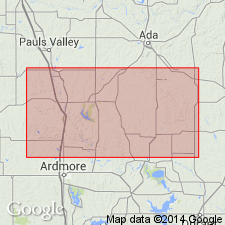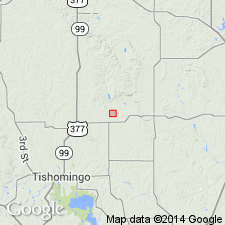
- Usage in publication:
-
- sand Branch member
- Modifications:
-
- Named
- Dominant lithology:
-
- Shale
- Gypsum
- Limestone
- AAPG geologic province:
-
- Arkoma basin
Summary:
Named as uppermost member (of 3) of Caney shale; named from Sand Branch, eastern tributary of Clear Boggy Creek. Type locality designated in NW1/4 sec 8, T2N, R7E, Pontotoc Co, OK in Arkoma basin; only lower part of member here exposed, but in no area have both lower and upper parts been seen together. Occurs in the northern Arbuckle Mountains of south-central OK. Consists of dark-gray to black, finely laminated to flaky, non-calcareous, bituminous shale, commonly shattered, with prolific small crystals of gypsum, and small, subspherical to pancake-like phosphatic concretions which are locally abundant. Gray to dark-gray limestone concretions, large to very large (as much as 4+ ft), tend to develop in large numbers along some bedding planes. Contains four lentils differentiated from each other by distinct faunal changes, both in goniatites and conodonts. Thickness given as about 130 ft in NE1/4 sec 14, T2S, R7E (measured section at Delaware Creek member, the type locality). Overlies Delaware Creek member (new) of Caney shale; underlies Rhoda Creek formation (new) at its type locality. Stratigraphic table; list of invertebrate fossils (brachiopods, conodonts, pelecypods, goniatites, cephalopods, gastropods). Of Mississippian (Chester) age.
Source: GNU records (USGS DDS-6; Denver GNULEX).

- Usage in publication:
-
- Sand Branch member
- Modifications:
-
- Overview
- AAPG geologic province:
-
- South Oklahoma folded belt
Summary:
Type section designated for Caney shale in sec 14, T2S, R7E, Johnston Co, OK in S. Oklahoma folded belt province; called section "A" in this report (where Caney is 180.85 ft thick). Augmented by sections "B" through "D". Caney contains three members, previously named by Elias (1956): Ahloso member (at base; previously called Ahlosa, but correct spelling is Ahloso), Delaware Creek member, and Sand Branch member (at top). Goddard shale is considered a facies of Sand Branch member. The Johns Valley shale, as here interpreted, contains in its lower part probably an Ahloso equivalent, definitely a Delaware Creek equivalent, and possibly a Sand Branch equivalent. Delaware Creek correlates with the Moorefield of northeastern OK and AR. Sand Branch contains a fauna similar to those of the Fayetteville and the Pitkin of northeastern OK. The Sycamore sandstone exposed below the Caney type section is quite unlike the Sycamore of its type area and may be a facies of Ahloso member. Type section for Ahloso is section "D," beds 10-18 (49.2 ft); type section for Delaware Creek is section "C," beds 38-97 (164.8 ft); and type section for Sand Branch is section "B," beds 4-37 (172.5 ft). Caney shale is of Mississippian age--its Ahloso member is of Meramecian age, its Delaware Creek member is of later Meramecian and early Chesterian age, and its Sand Branch member is of late Chesterian age.
Source: GNU records (USGS DDS-6; Denver GNULEX).
For more information, please contact Nancy Stamm, Geologic Names Committee Secretary.
Asterisk (*) indicates published by U.S. Geological Survey authors.
"No current usage" (†) implies that a name has been abandoned or has fallen into disuse. Former usage and, if known, replacement name given in parentheses ( ).
Slash (/) indicates name conflicts with nomenclatural guidelines (CSN, 1933; ACSN, 1961, 1970; NACSN, 1983, 2005, 2021). May be explained within brackets ([ ]).

